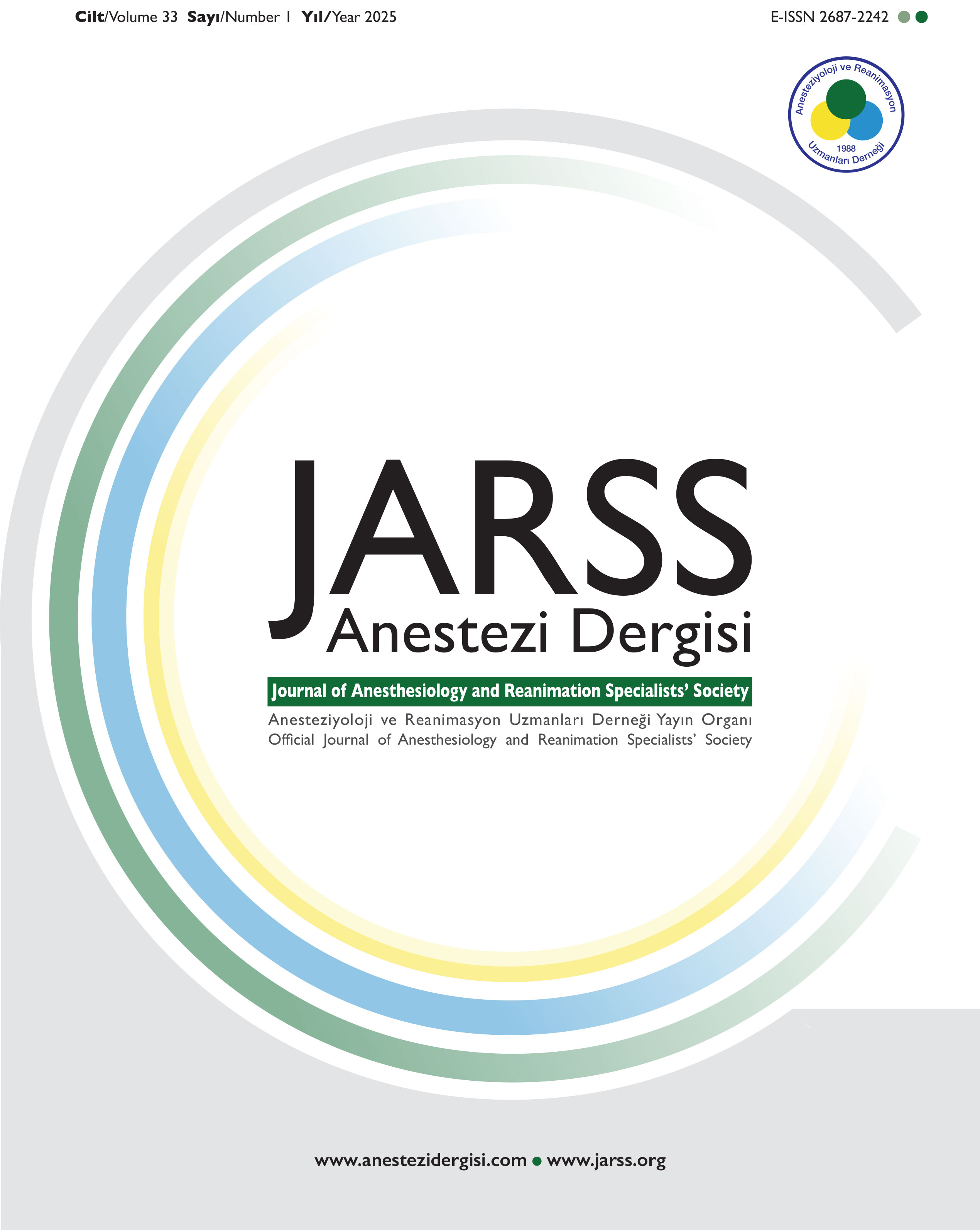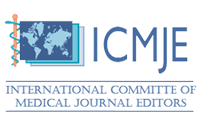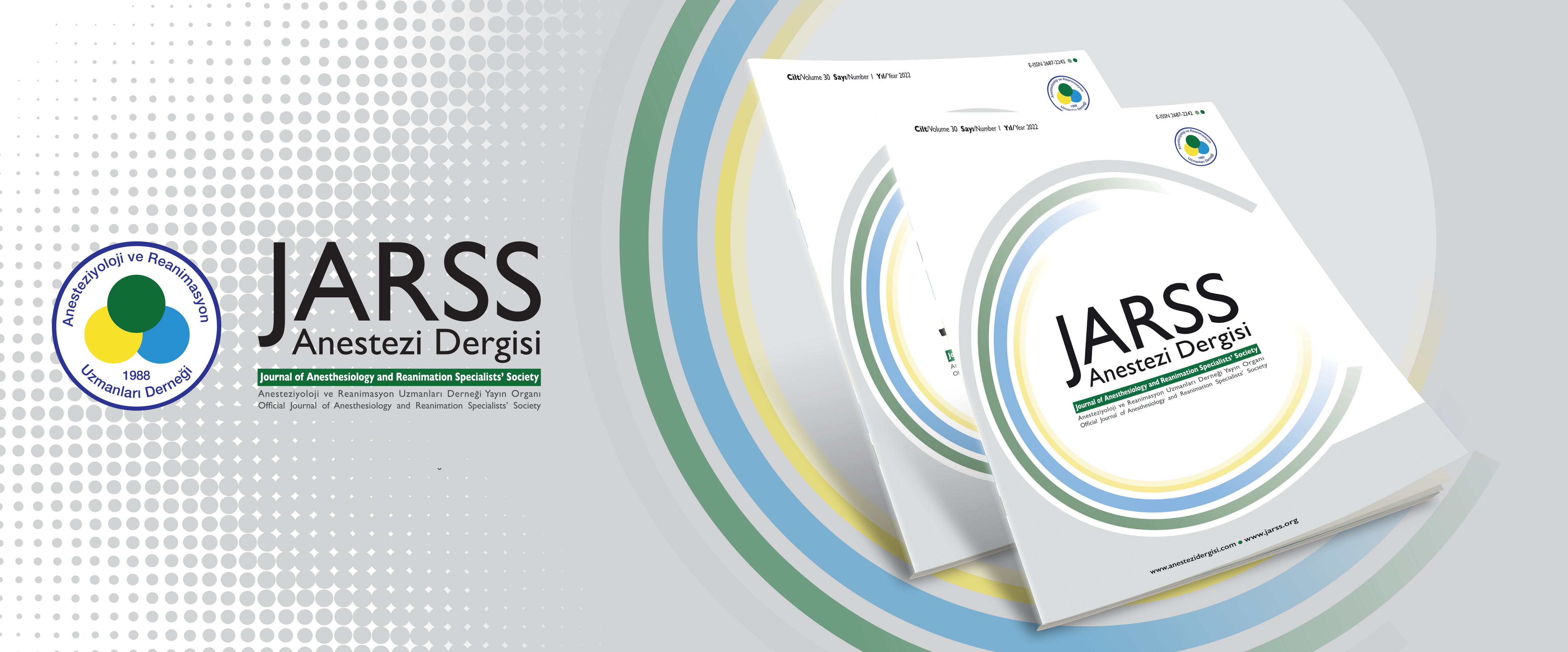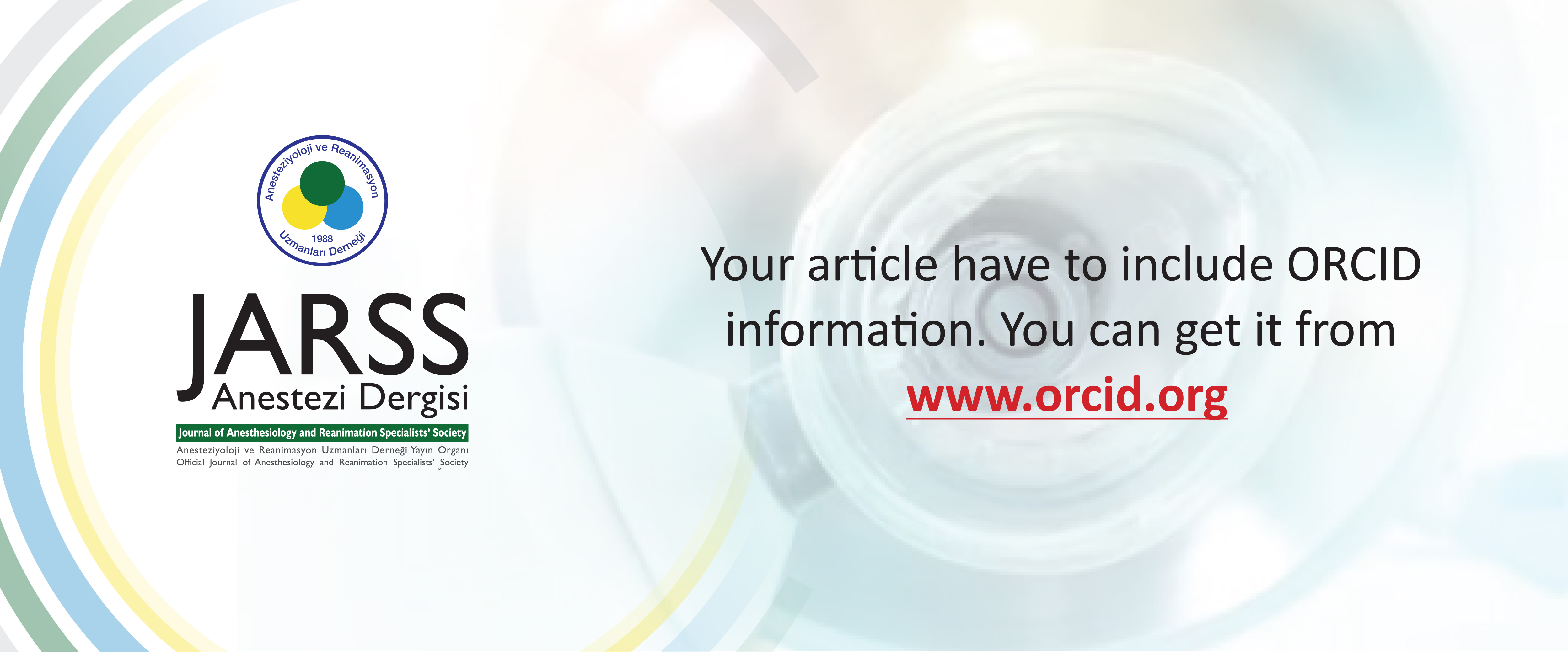Volume: 28 Issue: 2 - 2020
| 1. | Cover Page I (771 accesses) |
| 2. | Contents Pages II - III (698 accesses) |
| 3. | Advisory Board Pages IV - VI (725 accesses) |
| REVIEW | |
| 4. | Peroperative Period with Diabetes Mellitus Emine Ünal Ceran, Reyhan Polat doi: 10.5222/jarss.2020.85047 Pages 71 - 79 (2837 accesses) Diabetes mellitus is one of the most common chronic diseases. 25% of the patients to be operated are people diagnosed with diabetes mellitus. The peroperative evaluation of individuals with hyperglycemia is important to determine both anesthetic management and the patient's quality of life. In this review, physiopathology, diagnostic criteria, pharmacological and peroperative evaluation and management of diabetes are discussed. |
| ORIGINAL RESEARCH | |
| 5. | Evaluating the Effect of Being Away From Work Environment on Oxidative Stress Levels with Dynamic Thiol-Disulfide Homeostasis Among Anesthesiology Professionals Süheyla Abitağaoğlu, Ceren Köksal, Özcan Erel, Almila Şenat, Dilek Erdoğan Arı doi: 10.5222/jarss.2020.05925 Pages 80 - 84 (1053 accesses) INTRODUCTION: Exposure to anesthetic gases and occupational stress lead to increased levels of oxidative stress in anesthesiology professionals. Our study aims to investigate the effects of being away from anesthetic practice on oxidative stress with thiol-disulfide balance in anesthesia employees METHODS: The study included a total of 29 volunteer anesthesiology specialist, residents and technicians working in anesthesiology practice and planning on taking at least 1-week’s leave. Demographic data, working times and duties were recorded. A blood sample was taken from the participants on the day before they went on leave and on the day they returned, to study dynamic thiol-disulfide homeostasis. Increased native and total thiol levels and decreased disulfide levels after returning were evaluated as a decrease in oxidative stress. The data were assessed with a t-test, a one-way analysis of variance, a paired t-test; and p<0,05 was considered statistically significant. RESULTS: The mean leave was 10.7±3 days. Specialists had a higher mean age, while residents had a shorter working time(p<0.001). Other demographic data and pre-leave native thiol, total thiol and disulfide values were similar in three groups. A post-leave decrease in oxidative stress was noted among specialists and residents, whereas no significant change was observed in the technicians. DISCUSSION AND CONCLUSION: Based on the fact that decreasing levels of oxidative stress after 10-day leave, we believe that distancing the anesthesiology physicians from the work environment at specific intervals would be beneficial in terms of employee health. |
| 6. | Occupational Risk Awareness of Anesthesiologists: A Survey Study Emine Arık doi: 10.5222/jarss.2020.26234 Pages 85 - 92 (1678 accesses) INTRODUCTION: Anesthesiologists are exposed to many occupational hazards and risk factors that may adversely affect their health due to their working conditions. We planned this survey study in order to determine the awareness of anesthesiologists about their occupational risks and how much they have adopted employee safety in their daily practice. METHODS: The research data was collected through questionnaire forms, which were answered by face-to-face communication (distributing and filling out the printed questionnaires) with volunteer assistants and specialist physicians working in Anesthesiology and Reanimation Clinics in Education and Research Hospitals. While, correct answers were compared among all the doctors, in order to evaluate the relationship between correct answers and experience, another comparison was also made between the assistant doctors (GroupI) and the specialist doctors (Group II). RESULTS: As a result of our survey, the rate of all assistants and specialists responding correctly to the questionnaire was 41.6% (n = 70). 5 out of 12 questions were correctly answered with 50% or higher rate. When comparing between the groups, the assistant doctors answered only two questions statistically significantly correct when compared to the specialists whereas, specialist doctors answered 6 of the 12 questions statistically significantly correct when compared to the assistant doctor group. DISCUSSION AND CONCLUSION: In our questionnaire, it was observed that our anesthesiologists don’t know the professional risks and the occupational safety awareness level is not sufficient. Awareness should be raised with regular training programs in order to overcome these shortcomings and working under safe conditions should be adopted as a professional culture. |
| 7. | Anesthetic Management in Robotic Cardiac Surgery; Our Clinical Experiences Mehmet Emin İnce, Nadide Ors, Gökhan Özkan, Murat Kadan, Gökhan Erol, Suat Doğancı, Cengiz Bolcal, Vedat Yıldırım doi: 10.5222/jarss.2020.29200 Pages 93 - 99 (1183 accesses) INTRODUCTION: Minimally invasive surgical approaches have various potential benefits, as well as new challenges for anesthesia and surgical teams. In this study, we aimed to present our anesthesia experience in robotic cardiac surgery procedures performed in our clinic with current information. METHODS: This study included 227 (120 men, 107 women) patients who underwent robotic cardiac surgery performed via right thoracotomy between October 2014 and December 2019. Demographic data, type of surgery, EuroSCORE values, cross-clamp and cardio-pulmonary bypass time, postoperative complications, length of intensive care and hospital stays were obtained from patients' files and anesthesia follow-up forms. RESULTS: ASD-VSD was performed in 101 patients, valve surgery in 114 patients, and intracardiac mass excision in 13 patients with robotic surgery. 15 of these procedures were performed with in the beating heart. Median extubation time of the patients after surgery was 5 hours, median length of intensive care and hospital stays were 1, 7 days respectively. Due to the need for prolonged mechanical ventilation in the postoperative period, 3 patients underwent tracheostomy. Pacemaker implantation was performed in 10 of the patients undergoing valve surgery. DISCUSSION AND CONCLUSION: In robotic cardiac surgery, which includes all the features of both thoracic and cardiac surgery, anesthetists must know the complications that may occur and plan in advance against them. In addition, it is necessary to gain the knowledge required for single lung ventilation and transesophageal echocardiography, which is an integral part of this particular surgery. |
| 8. | The Effects Of Axillary Nerve Block And Intravenous Regional Anesthesia On Ischemia-Reperfusion Injury Induced By Tourniquet Ersagun Tugcugil, Dilek Kutanis, Ahmet Besir, Müge Koşucu, Ahmet Mentese, Süleyman Caner Karahan, Selim Demir, Sedat Saylan, Ali Akdoğan doi: 10.5222/jarss.2020.39974 Pages 100 - 108 (1112 accesses) INTRODUCTION: We aimed to compare the effects of axillary nerve block and IVRA (Intravenous Regional Anesthesia) techniques used in patients planned to undergo hand surgery on tourniquet induced ischemia reperfusion injury. Ischemia due to the use of tourniquet and the subsequent reperfusion cause oxidative stress in the organism. Oxidative stress is a contributor for postoperative morbidity METHODS: The study included 65 patients who underwent hand surgery. The patients received axillary nerve block were assigned to Group A (n=33) and the patients received IVRA were assigned to Group I (n=32). Blood samples were collected at T1 before anesthesia, T2 immediately before tourniquet deflation, T3 5 min, T4 30 min and T5 4 hours after tourniquet deflation and serum TAS, TOS, OSI and IMA levels were studied RESULTS: Plasma IMA and OSI concentration was significantly higher in Group A than in Group I at T2, T3, T4 time points. Plasma TOS level was higher in Group A than in Group I at T3 time point. Plasma TAS level was significantly higher in Group I than in Group A at T2, T3, T4 time points. DISCUSSION AND CONCLUSION: IVRA was more effective than axillary block in preventing ischemia reperfusion injury induced by tourniquet used in hand surgery, but there was no difference between these two techniques in the fourth hour of reperfusion. |
| 9. | Comparison of Beck and State-Trait Anxiety Scales in the Evaluation of Preoperative Anxiety Kevser Peker doi: 10.5222/jarss.2020.50570 Pages 109 - 115 (2473 accesses) INTRODUCTION: The purpose of this study is to compare Beck Anxiety Inventory (BAI) and State Anxiety Inventory (STAI-II) and Continuous Anxiety Inventory (STAI-II), which are used to evaluate the anxiety levels of preoperative patients. METHODS: This is a prospective study, with participation of 109 voluntary patients who had undergone septorhinoplasty surgery in a university hospital between October 2018 and April 2019. The data were collected by personal information form, BAI and STAI-I and II. RESULTS: The mean anxiety level according to BAI was 12.77±7.09, the mean anxiety according to STAI-I was 41.60±11.07, and the anxiety average was 42.40±8.37 according to STAI-II. Anxiety scores were significantly higher in women with all three scales (p<0.001). A statistically significant relationship was found between BAI mean total score and STAI-I and STAI-II mean total score (p <0.001). DISCUSSION AND CONCLUSION: It was determined that patients experienced moderate anxiety with BAI, STAI-I and STAI-II scales before surgery. BAI can be used with high sensitivity and specificity in the evaluation of preoperative anxiety. |
| 10. | How Appropriate Are The Indications for Parenteral Nutrition Patients? Halil Erkan Sayan doi: 10.5222/jarss.2020.52724 Pages 116 - 123 (2434 accesses) INTRODUCTION: Parenteral nutrition (PN) is a treatment method that provides intravenous nutrition. PN may improve clinical outcomes and may lead to an increase in mortality and morbidity due to complications. The aim of this study was to evaluate the indications of PN, to determine the incidence of inappropriate PN onset, and to investigate caloric adequacy. METHODS: All patients who were started PN were detected and visited by the nutrition nurse and dietician from the hospital database. Demographic data, service, diagnosis, PN compliance, indications, calorie intake and adequacy of the patients were evaluated. Each patient receiving PN was examined according to the guidelines of the European Association of Clinical Nutrition and Metabolism (ESPEN) and classified as “appropriate” and “inappropriate”. In addition, patients receiving PN were divided into 4 categories as Peripheral PN, Central PN, Enteral+PN, Oral+PN. RESULTS: In our hospital, 333 patients underwent PN for six months. PN was started due to vomiting (37%), obstructive bowel disease (27%), severe diarrhea (12%) and severe malabsorption (12%). 153 (45.9%) of the patients were started with inappropriate indication. The most frequent reasons for inappropriate indication were the preference of the doctor for conservative PN (142 cases, 92.8%). 256 (76.9%) of the patients receiving PN had inadequate calorie intake. Peripheral parenteral nutrition (PPN) (155 cases, 46.5%) was preferred the most route in the nutrition of the patients, nutrition inappropriate indication of PN (40%) and inadequate calorie (98.1%) were seen in this group. DISCUSSION AND CONCLUSION: Inappropriate use of PN was found to be 45.9% in our study. In previous studies, the use of “inappropriate” PN was reported to vary between 0% and 38%. In patients who cannot receive adequate oral or enteral nutrition for any reason, PN is initiated alone or in addition to enteral nutrition. In order to minimize the risks associated with PN, PN indications should be well known and nutrition-oriented training should be planned. We believe that the recommendations of the hospital nutritional support team (NDE) should be taken into consideration against the risk of inappropriate indication and insufficient calorie administration. |
| CASE REPORT | |
| 11. | Sedation Failure in a Patient with Fahr Syndrome in the Intensive Care Unit Büşra Tezcan, Çilem Bayındır Dicle, ibrahim Mungan, Derya Ademoğlu, Müçteba Can, Dilek Kazancı doi: 10.5222/jarss.2020.39358 Pages 124 - 127 (1000 accesses) Fahr Syndrome, which is a rare neurologic syndrome, is characterized by sporadic or genetically inherited basal ganglion calcification. There are some hypotheses about the pathophysiology of Fahr Syndrome like a defect in calcium metabolism, metastatic calcium deposits and increased free radical production.Although patients are usually diagnosed with extrapyramidal symptoms, they may also present with cerebellar dysfunction, speech disorders,dementia and neuropsychiatric symptoms.We aimed to discuss sedation failure with dexmedetomidine and midazolam in a 49-year-old female patient with Fahr Syndrome who was admitted to our intensive care unit after suicidal carbamazepine overdose in this case report. Adequate sedation levels could not be reached although 1.5 mcg/kg/h dexmedetomidine infusion and 1,5 mg midazolam bolus injections were administered. This may be due to the tolerance to sedatives developed by long-term use of antidepressant and antiepileptic agents. On the other hand; the unique sedative agent dexmedetomidine is a specific and selective α2 agonist and the widespread intracerebral calcification in our patient may have impaired α2 receptor activity.Besides that, calcium metabolism disorder, one of the probable causes of Fahr Syndrome, may affect calcium-mediated inhibition of neurotransmitter release through α2 adrenoreceptors and reduced the effectiveness of dexmedetomidine. |
| 12. | ’Case Report: Infraclavicular Block In A Patient With Takayasu's Arteritis Melis Sumak Hazır, Derya Özkan, Mukaddes Tuğba Arslan doi: 10.5222/jarss.2020.54227 Pages 128 - 130 (948 accesses) Takayasu arteritis (TA),also known as pulseless disease, is a rare chronic progressive inflammatory panarteritis. In this case report, infraclavicular brachial plexus block application and perioperative anesthesia management were discussed in a patient with TA who is scheduled for elective distal radius fracture operation. |
| 13. | Anesthesia Management in a Patient with Waardenburg Syndrome Yonca Özvardar Pekcan, Bahattin Tuncali, Özlem Yılmaz Sümer doi: 10.5222/jarss.2020.94914 Pages 131 - 134 (1652 accesses) Waardenburg syndrome (WS) is most often inherited as an autosomal dominant trait characterized with complete or partial absence of melanocytes from the beginning of embryogenesis. Ten year old patient with WS underwent cochlear implant operation because of hearing loss in the left ear. Physical examination was normal except a white forelock, heterochromia of iris, characteristic bright blue iris in the right eye, brown iris in the left eye, broad nasal root, partial synophrys, bilateral sensorineural hearing loss, hypopigmented areas on the 2nd, 3rd,4th and 5th fingers of the left hand and the wrist. Airway examination was evaluated as Mallampati II. After premedication with midazolam, anesthesia was induced with 1 µgr kg-1 fentanyl, 2.5 mg kg -1 propofol. Endotracheal intubation was facilitated by 0.6 mg kg-1 tracrium. The maintenance of anesthesia was provided with intravenous infusion of propofol ( 0.75µgr kg-1 min-1) and remifentanil ( 0.25 µgr kg-1 min-1) has been used. After the operation the patient was extubated and transferred to the ward without problem. We believe that, awareness of the characteristics of WS, well-planned anesthesia management, controlled hypotension and the use of total intravenous anesthesia are the essentials of the successful anesthesia management in these cases. |
| LETTER TO THE EDITOR | |
| 14. | Acute Compartment Syndrome of Hand in a Pediatric Patient: Intravenous Infiltration and Cannula Dressing as Culprit Neeraj Kumar, Abhyuday Kumar, Amarjeet Kumar, Amit Kumar Sinha doi: 10.5222/jarss.2020.44127 Pages 135 - 136 (847 accesses) Abstract | |

















